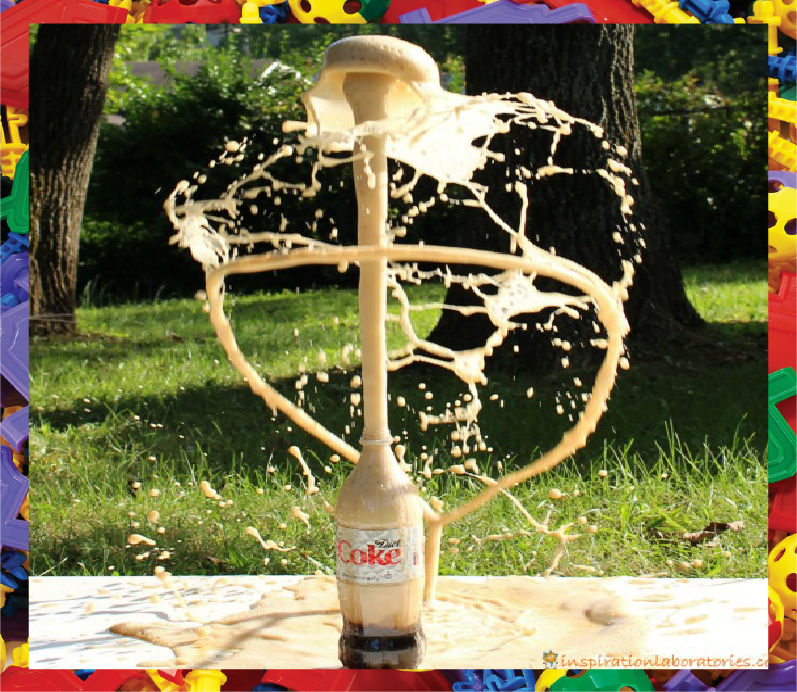

Can chewing gum make you smarter? Can a lemon turn on a lightbulb? You could find out when the next school fair comes around! While volcanoes and tornadoes are cool, it’s time to upgrade your science game with some impressive experiments. Unleash your inner Thomas Edison or Marie Curie with these ideas.
Please conduct these experiments under adult supervision and take proper precautions!
GET SMARTER BY
CHEWING GUM?
Do you believe chewing gum can make your mind work faster? Let’s put this hypothesis to the test. You’ll have to ask a friend to partner with you on this fun science fair experiment. Use a Sudoku puzzle or a math problem as a test. Ask your friend to take the test while you’re

chewing gum and record the time it takes both of you to finish the puzzle or quiz. Another great idea is to come up with 4-5 pairs of unconnected words like “day/book or pond/tree, and give your friend 30 seconds to study them. Test by saying the first word yourself and asking your friend to identify the other. Redo the experiment, only this time with your friend chewing the gum and see if their brain performs better.

A SODA GEYSER
You’ve probably heard of a water geyser, but how awesome would it be to make your own soda geyser with only a fountain soda and a roll of Mentos mints? Take a big bottle of diet soda, about half a gallon, and throw in the Mentos to watch the carbon dioxide bubbles form. As the bubbles form, they bind to the Mentos inside and keep building up as the candy dissolves. If you’ve dropped in an entire roll, your soda geyser could be gigantic, up to 6 feet! Word of caution: Do not try this indoors!
VEGETABLE BATTERY
You might hate having them for dinner, but vegetables can really light up an LED or a bulb. Use a lemon, a copper coin and a galvanized nail attached to a light bulb and find out for yourself. You can choose different fruits and vegetables like lemons, potatoes and tomatoes to test the efficiency of electricity production. Record the current readings using a digital multimeter and pen down the results for increased accuracy. What’s the connection between vegetables and electrolytes? The

principle behind the science experiment is the vegetables or fruits will generate and transport a current when placed between two different conductors or metals.

POWER A RADIO
WITH SOLAR ENERGY
To use the sun’s energy to power a radio, you need a small solar panel and a 6-volt radio powered by 4 AA batteries. The catch is to tally the power from your solar panel with the amount required by your radio. To connect the solar panel to the radio’s terminals, open the radio and see how the wires are arranged inside. Usually the radio has a positive and negative
lead, so configuring the radio with your solar panel should be pretty simple. The radio will turn on once it has charged up using solar energy.
POWER A RADIO
WITH SOLAR ENERGY
To use the sun’s energy to power a radio, you need a small solar panel and a 6-volt radio powered by 4 AA batteries. The catch is to tally the power from your solar panel with the amount required by your radio. To connect the solar panel to the radio’s terminals, open the radio and see how the wires are arranged inside. Usually the radio has a positive and negative lead, so configuring the radio with your solar panel should be pretty simple. The radio will turn on once it has charged up using solar energy.
SPLIT WATER
THROUGH HYDROLYSIS
What does splitting water even mean? You can conduct a hydrolysis experiment to find out! This project requires a 9 Volt battery and a container of water. Immerse the battery with wires attached to its terminals in a solution of salty or distilled water. As soon as the water is split by the electric current,

you’ll notice bubbles shaping up around the wire ends. The bubbles are formed by Hydrogen and Oxygen, which make up water. You can also make use of other materials for the electrodes, like the graphite from your pencil, to test the different results.
There are a ton of other ideas out there for elementary, middle and high school students, including exploring plant science using red beans or growing crystals from metal salts. These experiments help kids learn about science in a fun way and share their knowledge with friends. You might not be able to ace your next math quiz just by chewing gum, but it’s still fun to consider the possibilities!
References
https://sciencing.com/top-ten-popular-science-projects-6570510.html
https://www.sciencebuddies.org/blog/success-story-science-fair-projects-with-real-world-impact
http://www.makeitsolar.com/science-fair-ideas/12-solar-radio.htm
https://www.solarmehome.com/science-project-series-solar-powered-radio/
https://www.bbvaopenmind.com/en/the-great-invention-of-marie-curie/
https://abbotbeynelearning.files.wordpress.com/2013/06/solar-system-display-e1370762805663.jpg
https://cdn-images-1.medium.com/max/1024/1*oVqRbwsUDBgV8c6NF965gw.jpeg
http://inspirationlaboratories.com/wp-content/uploads/2016/09/soda-geyser-1L-sq.jpg
https://media.treehugger.com/assets/images/2014/07/solar_cooler_stereo.jpg
https://videos.files.wordpress.com/wcaXiwNV/img_3136_dvd.original.jpg








